Baculellum articulatum
Baculellum articulatum (L.f.) L.V.Ozerova & A.C.Timonin (= Curio articulatus (L.f.) P.V.Heath, Senecio articulatus (L.f.) Sch.Bip.)
Family: Asteraceae
Common names: sausage plant, candle plant, hot dog plant (Eng.); worsies, worsiesplantjie (Afr.)
Introduction
This little succulent plant from the daisy family, known as sausage plant or candle plant, is so named for its distinctive jointed, swollen stems.
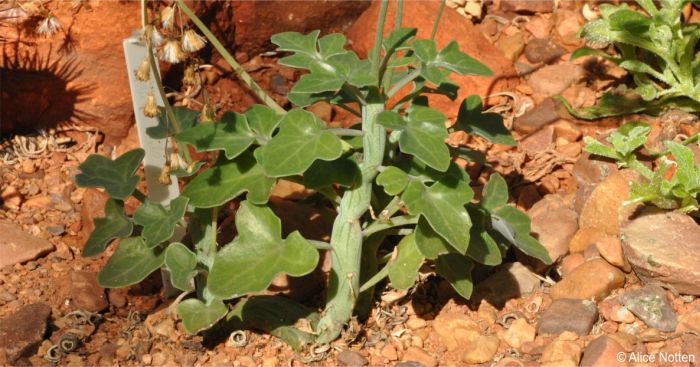
Description
Description
Baculellum articulatum (formerly known as Curio articulatus, Senecio articulatus and Kleinia articulata) is a semi-decumbent plant to 600 mm tall, with pale, grey green, ±17 mm thick, cylindrical, articulated, succulent stems with darker green or purple markings just below the petioles. The leaves are arrowhead-shaped (sagittate), toothed, somewhat succulent, with a distinct upper and lower surface (bifacial) and a petiole.
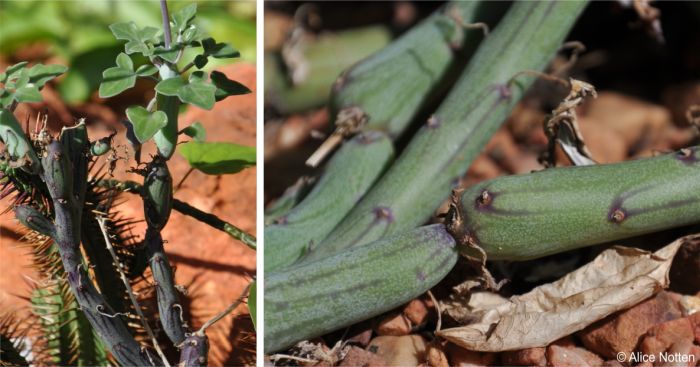
The flower heads are discoid (without ray petals), looking like small green cups packed full of little white flowers becoming yellow as the flowers open. They are presented at the tips of long, branched flower stalks, about 120 mm long, that grow towards the ends of the stems, in winter (April to June). The flowers have white petals, and purple anthers with yellow pollen, and yellow bi-lobed stigmas that protrude from the flowers. The fruit is an achene with pappus of long white hairs.
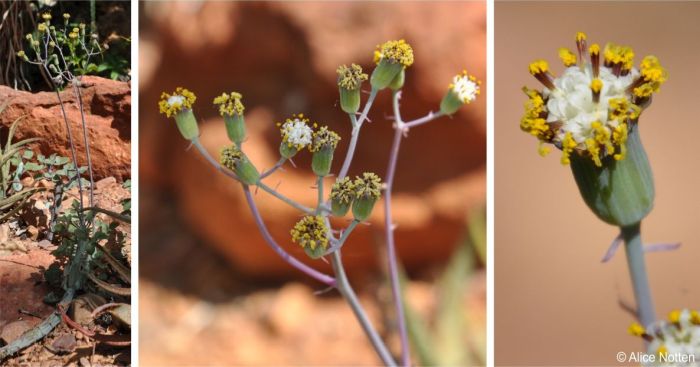
Conservation Status
Status
Least Concern (LC), Baculellum articulatum is common and widespread and is not currently threatened, according to the Red List of South African Plants.
Distribution and habitat
Distribution description
Baculellum articulatum is a South African endemic, occurring in the Eastern Cape and Western Cape, between Montagu, Prince Albert and Makhanda, in the Little Karoo and Great Karoo. It grows on rocky slopes, often in shade or under bushes.
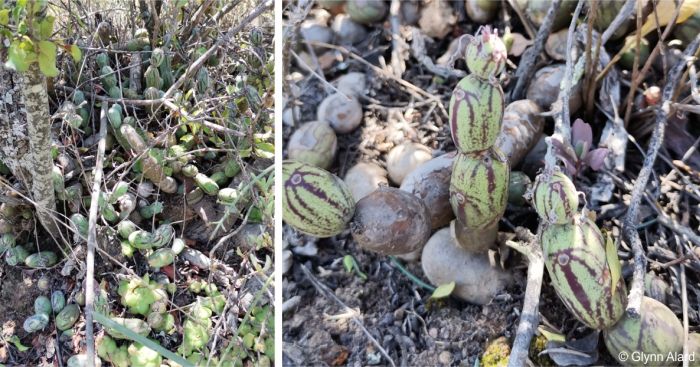
Derivation of name and historical aspects
History
The genus name Baculellum, meaning ‘little stick’ is derived from the Latin baculum, meaning ‘peg’ or ‘stick’. The species name articulatum is also Latin, meaning ‘jointed’ or ‘with joints’. Both names referring to the distinctive stems of the plant.
Baculellum articulatum has proved difficult to classify taxonomically. It was first named Cacalia articulata by Linnaeus in 1781, and was moved to Kleinia by Haworth in 1812, then moved to Senecio by Schultz Bipontinus in 1845 and finally moved to Curio by Heath in 1997. It has the typical floral structure of Curio but has very different leaves and stems. A genetic analysis in 2017 by Ozerova, Schanzer and Timonin established that this species is distant enough from Curio and unlike any other species in the group to justify it being placed in a new genus, Baculellum. Their data shows that it diverged early from the Curio clade and lies somewhere between the Curio clade and Gynura-Solanecio-Kleinia assemblage within the subtribe Senecioninae.
Baculellum is a small genus, containing one species (monotypic). It belongs to the Asteraceae, a large family which includes over 25 000 species of flowering plants.
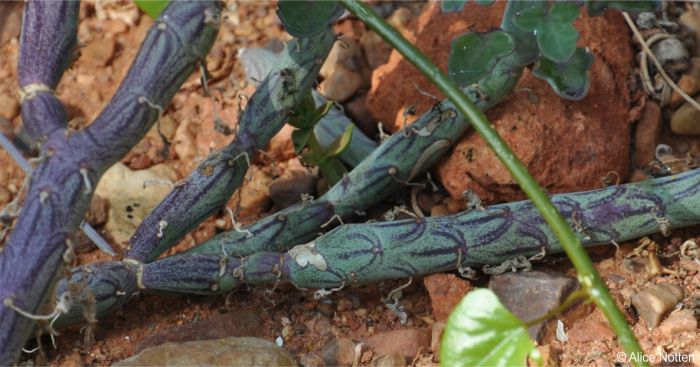
Ecology
Ecology
Baculellum articulatum is a deciduous succulent plant that is native to the dry, semi-arid Karoo region of South Africa. Its succulent stems and leaves store water, enabling the plant to survive the dry conditions. The leaves are absent during the summer dry season.
The flowers are inconspicuous and foul smelling and are pollinated by insects, such as flies. The seeds are dispersed by wind. Broken or detached pieces of stem root easily where they land on suitable substrate, allowing plants to recover after disturbances such as trampling or grazing.
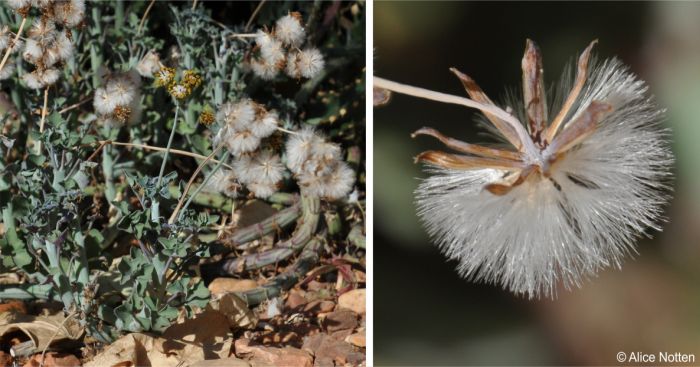
Uses
Use
This plant is well-established in cultivation, with variegated forms available, and makes a rewarding pot plant. It is not known to be used in traditional medicine and it is not edible.
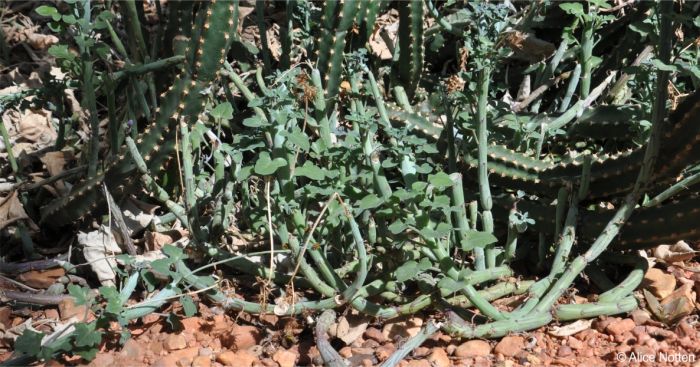
Growing Baculellum articulatum
Grow
New plants are easily propagated using stem cuttings or by division of a clump. To propagate by cuttings, cut just below a joint segment, allow it to dry overnight, and place it in a well-drained soil mix suitable for succulent plants. Detached pieces of stem will also root easily when planted in soil.
Grow Baculellum articulatum in well-drained, sandy soil in a semi-shaded or lightly shaded, well-ventilated position. Best suited to rock gardens in karoo, dry fynbos and arid regions, and containers. Feed with compost or balanced organic fertiliser. Containerised plants should be repotted in early spring. Water moderately all year but take care not to overwater.
References
- Alard, G. 2022-Feb. Observation of Baculellum articulatus, Klein Karoo, Western Cape. iNaturalist. Online. https://www.inaturalist.org/observations/148104884.
- Herman, P.P.J. 2004. Asteraceae. (Compositae). PlantZAfrica. Online. http://pza.sanbi.org/Asteraceae.
- Manning, J. & Goldblatt, P. 2012. Plants of the Greater Cape Floristic Region 1: the Core Cape Flora. Strelitzia 29. South African National Biodiversity Institute, Pretoria.
- Ozerova, L.V., Schanzer, I.A. & Timonin, A.C. 2017. Curio alliance (Asteraceae: Senecioneae) revisited. Wulfenia 24:29–52.
- Pole Evans, I.B. (ed) 1929. Kleinia articulata. The Flowering plants of South Africa 9:pt.332. https://www.biodiversitylibrary.org/item/335669#page/55/mode/1up.
- Snijman, D.A. (ed.). 2013. Plants of the Greater Cape Floristic Region 2: The Extra Cape Flora. Strelitzia 30. South African National Biodiversity Institute, Pretoria.
- Von Staden, L. 2023. Curio articulatus (L.f.) P.V.Heath. National Assessment: Red List of South African Plants. Accessed on 2024/09/11.
Credits
Samuel Lekhetho, Free State National Botanical Garden
and Alice Notten, Kirstenbosch National Botanical Garden
September 2024
Acknowledgements: images by Alice Notten and Glynn Alard.
Plant Attributes:
Plant Type: Succulent
SA Distribution: Eastern Cape, Western Cape
Soil type: Sandy, Loam
Flowering season: Autumn, Winter
PH: Acid, Neutral
Flower colour: Green, White, Yellow
Aspect: Morning Sun (Semi Shade), Afternoon Sun (Semi Shade)
Gardening skill: Easy
Special Features:
Horticultural zones








Rate this article
Article well written and informative
Rate this plant
Is this an interesting plant?
Login to add your Comment
Back to topNot registered yet? Click here to register.